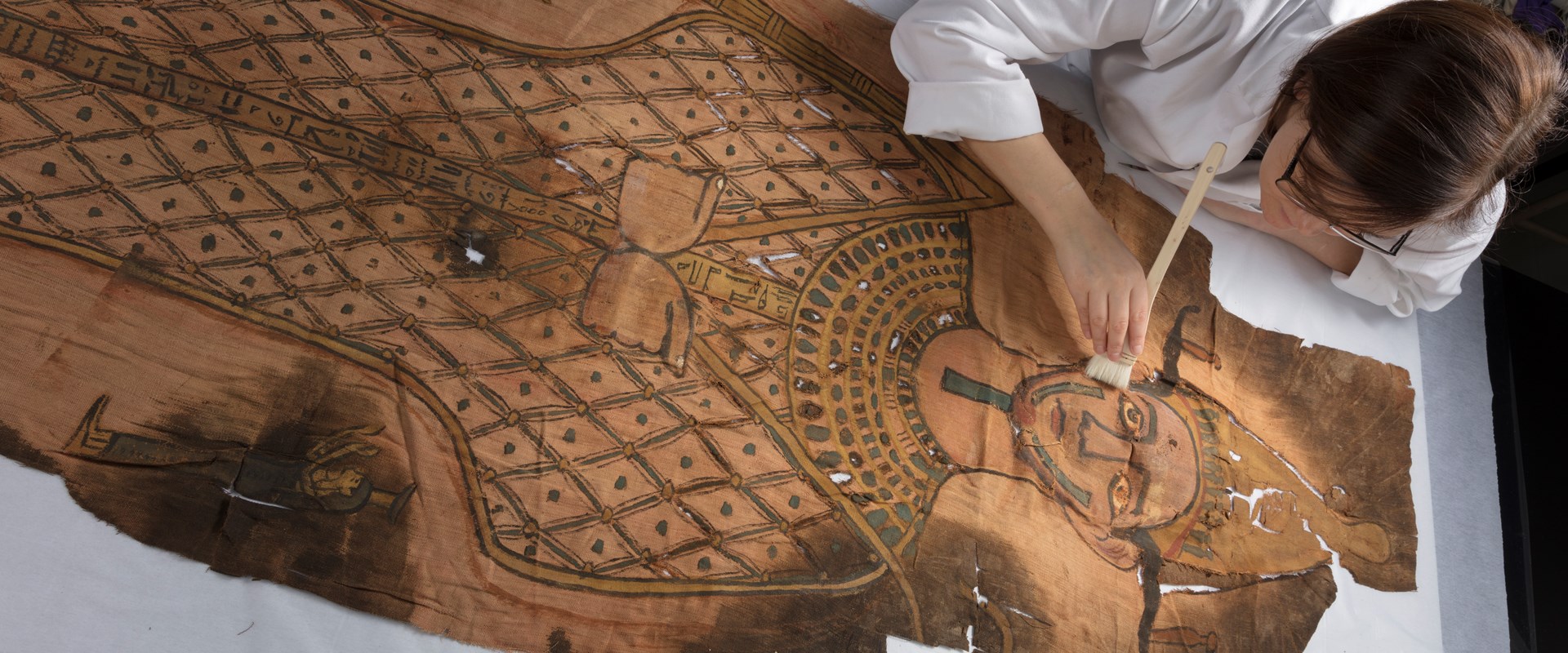The Tomb: Ancient Egyptian Burial
Friday 31 March 2017 to Sunday 3 September 2017
National Museum of Scotland, Chambers Street, Edinburgh
Admission: FREE
A unique, full-length mummy shroud, which is over 2,000 years old yet is still in remarkable condition, has been discovered in National Museums Scotland’s collections. It will be displayed for the first time in The Tomb: Ancient Egyptian Burial, a new exhibition opening at the National Museum of Scotland on 31 March.
The shroud, which dates to approximately 9 BC, was discovered by curators during an in-depth assessment of National Museums Scotland’s internationally significant ancient Egyptian collections in preparation for a new, permanent ancient Egypt gallery which will open at the Museum in 2018/19.
Dr Margaret Maitland, Senior Curator of Ancient Mediterranean collections found the folded shroud wrapped in brown parcel paper, with a note written by a past curator in a Second World War service envelope identifying the contents as having come from an ancient Egyptian tomb. The package had been stored since the mid-1940s.
Due to the fragility of the ancient textile, conservators gently humidified it so that the fibres would become less dry and brittle. This allowed them to carefully unfold the shroud, a process which took almost 24 hours. Upon unfolding it, a hieroglyphic inscription on the shroud revealed the identity of the owner to be the previously unknown son of the Roman-era high-official Montsuef and his wife Tanuat.
Dr Margaret Maitland, Senior Curator, Ancient Mediterranean at National Museums Scotland said:
“To discover an object of this importance in our collections, and in such good condition, is a curator’s dream. Before we were able to unfold the textile, tantalising glimpses of colourful painted details suggested that it might be a mummy shroud, but none of us could have imagined the remarkable figure that would greet us when we were finally able to unroll it. The shroud is a very rare object in superb condition and is executed in a highly unusual artistic style, suggestive of Roman period Egyptian art, yet still very distinctive.”
In ancient Egypt, following mummification, a shroud was commonly wrapped around the body before it was placed in a coffin. In Roman-era Egypt, shrouds became increasingly important as the use of coffins became rarer.
This full-length, painted linen shroud is unique, with very few parallels from its period. It depicts the deceased as the god Osiris. Because of its owner’s direct relationship to Montsuef and Tanuat, whose deaths were recorded to have occurred in 9 BC, it is possible to date the shroud relatively precisely, which is extraordinary for such an ancient artefact.
The shroud comes from a Roman-era burial in a tomb originally built around 1290 BC opposite the great city of Thebes (modern-day Luxor). First built for a chief of police and his wife, it was looted and reused several times, before being sealed in the early 1st century AD.
It was undisturbed until its excavation in the 19th century when a collection of beautiful objects from various eras was discovered. The shroud is one of a number of objects from this tomb which are in National Museums Scotland’s collections. The Tomb: Ancient Egyptian Burial, which is sponsored by Shepherd and Wedderburn, will tell the story of this tomb across 1,000 years of use.
Dr Margaret Maitland added:
“It is extraordinarily rare that we have such an incredible group of objects belonging to a whole ancient Egyptian family in our collections. To have been able to expand this group of objects with this new discovery is very exciting, and further enhances our understanding of the story of this wonderful tomb and its occupants.”
Further information and images from: Alice Wyllie, Susan Gray or Jessica Rideout, National Museums Scotland Press Office on 0131 247 4288 or a.wyllie@nms.ac.uk.
Notes to Editors
-
National Museums Scotland is one of the leading museum groups in the UK and Europe and it looks after collections of national and international importance. The organisation provides loans, partnerships, research and training in Scotland and internationally. Our individual museums are the National Museum of Scotland, the National Museum of Flight, the National Museum of Rural Life and the National War Museum. The National Museums Collection Centre in Edinburgh houses conservation and research facilities as well as collections not currently on display.
-
The National Museum of Scotland is the most popular museum in the country outside of London (source: Association of Leading Visitor Attractions). The National Museum of Scotland was awarded ‘Gold’ Level Green Tourism Visitor Attraction status in 2016.

